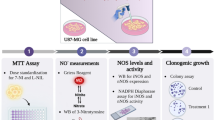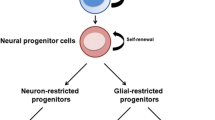Abstract
Objectives
One of the fundamental aspects of nitric oxide (NO) is the regulation of the inflammatory processes involved in neuronal apoptosis. Expressions of NO and NO synthase (NOS) are considered to be involved in brain tissue injuries and brain tumors. The purpose of our study was to investigate the roles of NO and inducible-form NOS (iNOS) in the pathogenesis of brain tumors.
Methods
NO levels in the cerebrospinal fluid (CSF) of 36 brain tumor patients were detected utilizing the NO-chemiluminescence method. Deparaffinized tissue sections were immunostained for the presence of antibodies against iNOS and for apoptosis using the TUNEL stain. The results were compared with 10 control patients (with epilepsy and hydrocephalus).
Conclusions
Higher levels of NO and iNOS activities may induce immune responses and neurotoxicities. This preliminary study revealed elevated NO and NOS activities with an increased amount of apoptotic processes in brain tumor tissues, which may indicate the possible roles of NO in the formation of brain tumors.



Similar content being viewed by others
References
Anggard E (1994) Nitric oxide: mediator, murderer, and medicine. Lancet 343:1199–1206
Bakshi A, Nag TC, Wadhwa S et al (1998) The expression of nitric oxide synthases in human brain tumors and peritumoral areas. J Neurol Sci 155:196–203
Bell KR, O'Dell MW, Barr K et al (1998) Rehabilitation of the patient with brain tumor. Arch Phys Med Rehabil 79:S37–S45
Chiou SH, Chang CJ, Chou CK et al (1999) Increased nitric oxide levels in aqueous humor of diabetic patients with neovascular glaucoma. Diabetes Care 22:861–862
Cobbs CS, Brenman JE, Aldape KD et al (1995) Expression of nitric oxide synthase in human central nervous system tumors. Cancer Res 55:727–730
Cross AH, Keeling RM, Goorha S et al (1996) Inducible nitric oxide synthase gene expression and enzyme activity correlate with disease activity in murine experimental autoimmune encephalomyelitis. J Neuroimmunol 71:145–153
Dreyer EB, Zurakowski D, Schumer RA, Podos SM, Lipton SA (1996) Elevated glutamate in the vitreous body of human and monkey with glaucoma. Arch Ophthalmol 114:643–651
Iwata S, Nakagawa K, Harada H, Oka Y, Kumon Y, Sakaki S (1999) Endothelial nitric oxide synthase expression in tumor vasculature is correlated with malignancy in human supratentorial astrocytic tumors. Neurosurgery 45:24–29
Klem M, Dahmann R, Wink D, Feelisch M (1997) The nitric oxide/superoxide: insights into the biological chemistry of the NO/.O2 − interaction. J Biol Chem 272:9922–9932
Kornelisse RF (1996) The role of nitric oxide in bacterial meningitis in children. J Infect Dis 174:120–126
Kostka P (1995) Free radicals (nitric oxide). Anal Chem 67:411R–416R
Leib SL, Kim YS, Black SM et al (1998) Inducible nitric oxide synthase and the effect of aminoguanidine in experimental neonatal meningitis. J Infect Dis 177:692–700
Licinio J, Prolo P, McCann SM et al (1999) Brain iNOS: current understanding and clinical implications. Mol Med Today 5:225–232
Lowenstein CJ, Snyder SH (1992) Nitric oxide, a novel biological messenger. Cell 70:705–707
Ludwig HC, Feiz-Erfan I, Bockermann V, Behnke-Mursch J, Schallock K et al (2000) Expression of nitric oxide synthase isozymes (NOS I–III) by immunohistochemistry and DNA in situ hybridization. Correlation with macrophage presence, vascular endothelial growth factor (VEGF) and edema volumetric data in 220 glioblastomas. Anticancer Res 20:299–304
Mork SJ, Wester K (1998) Malignant gliomas: histological features, invasion, and relation to clinical symptoms. In: Mikkelsen T, Bjerkvig R, Laerum OD (eds) Brain tumor invasion, biological, clinical and therapeutic considerations. Wiley, New York, pp 89–110
Stover JF, Pleines UE, Morganti-Kossmann MC et al (1997) Neurotransmitters in cerebrospinal fluid reflect pathological activity. Eur J Clin Invest 27:1038–1043
Stover JF, Pleines UE, Morganit-Kossmann MC et al (1999) Thiopental and midazolam do not seem to impede metabolism of glutamate in brain-injured patients. Psychopharmacology 141:66–70
Uysal G, Yusel G, Sinav B et al (1999) Cerebrospinal fluid nitric oxide levels in childhood bacterial meningitis. Scand J Infect Dis 31:518–520
Wada K, Chatzipanteli K, Busto R, Dietrich WD (1999) Effects of L-NAME and 7-NI on NOS catalytic activity and behavioral outcome after traumatic brain injury in the rat. J Neurotrauma 16:203–212
Whittle IR, Collins F, Kelly PAT et al (1996) Nitric oxide synthase is expressed in experimental malignant glioma and influences tumor blood flow. Acta Neurochir (Wien) 138:870–876
Yamamura T (1996) Techniques for measurement of nitric oxide in biological system: principles and practices. Nippon Yakurigaku Zasshi 107:173–182
Acknowledgements
This study was supported by grants from the Taipei Veterans General Hospital and National Science Council (to C.-L.K, S.-H.C., and T.-T.W.).
Author information
Authors and Affiliations
Corresponding author
Rights and permissions
About this article
Cite this article
Kao, CL., Chiou, SH., Chen, HS. et al. Elevated nitric oxide levels in childhood brain tumors. Childs Nerv Syst 19, 744–749 (2003). https://doi.org/10.1007/s00381-003-0796-z
Received:
Published:
Issue Date:
DOI: https://doi.org/10.1007/s00381-003-0796-z




